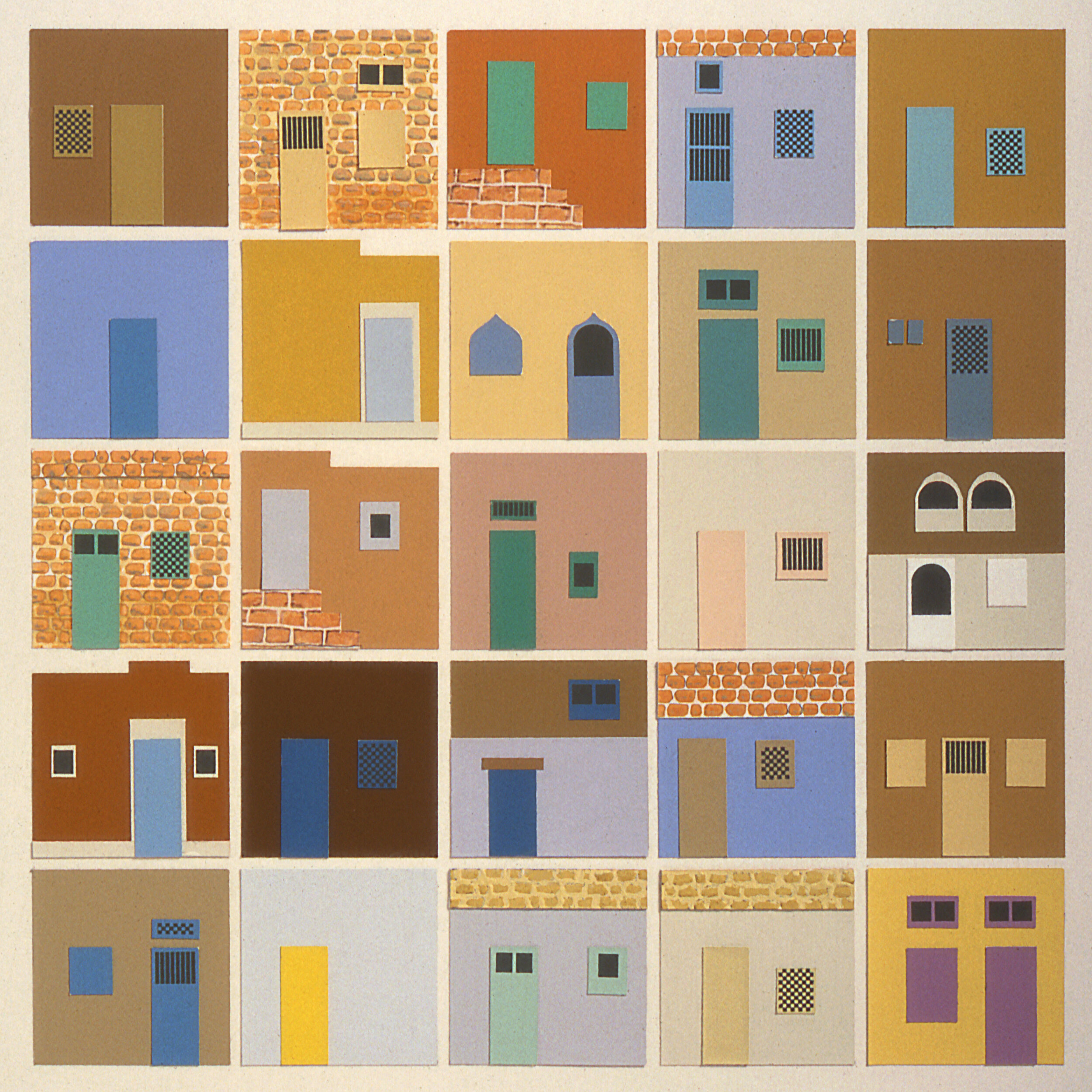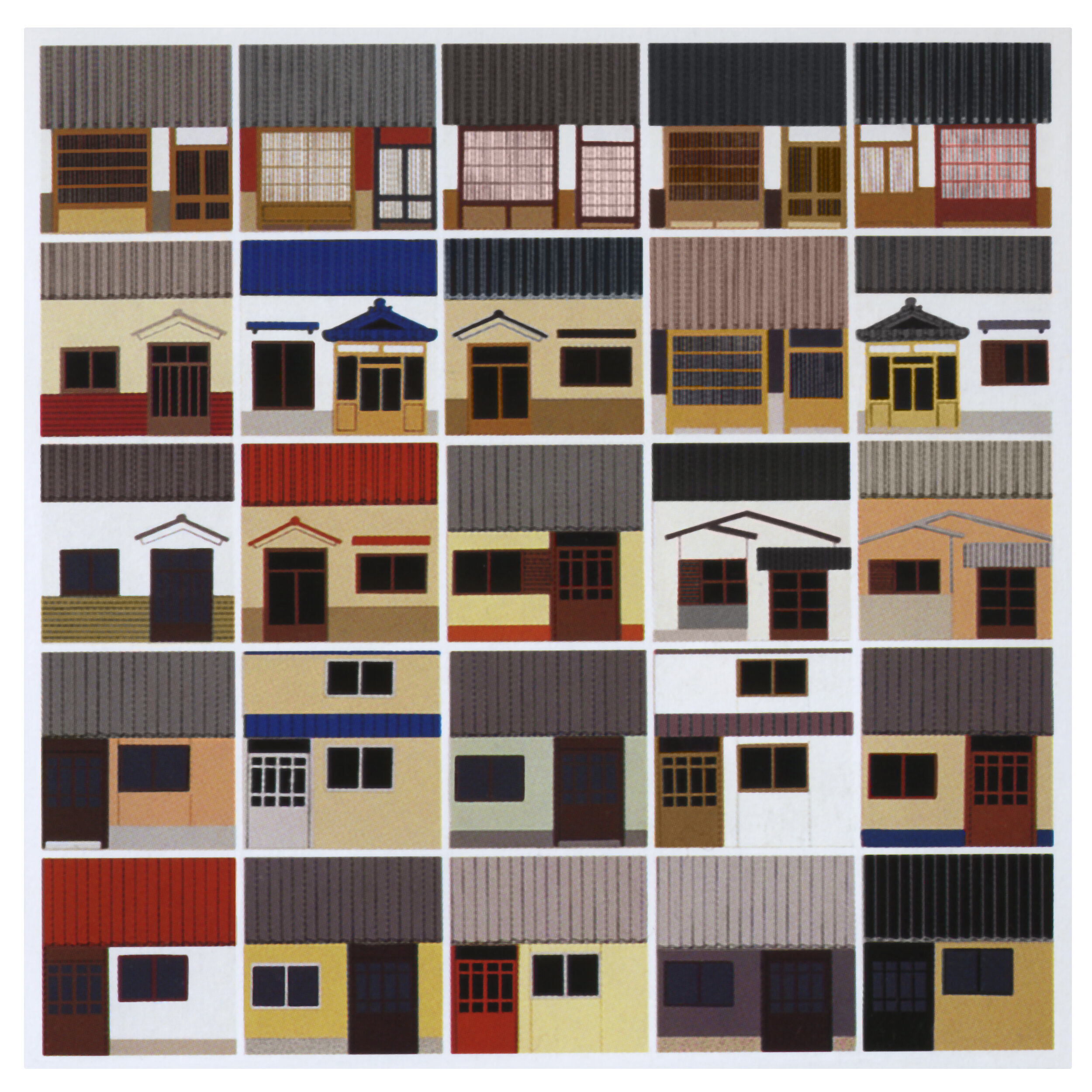Colours of the world
Between 1995 and 1999 Lenclos continued his studies into the colours of popular housing across the world. The country studies shown here give some idea of the diversity expressed through the colours of houses, towns, villages and landscapes. Every home is coloured, whether it’s made of earth, like the skyscrapers of Shibaum in Yemen, or the blue-washed walls of the houses of Jodhpur in India.
Photo: these fragments of roof tile were collected from a roofing company near Murotsu in Japan in 1997. The older terracotta tiles have a matt grey finish, whereas the more recent tiles are generally glazed.
↑ United States. New York. Greene Street in the district of Soho is characterised by all the fire escapes attached to the building facades. The dominant colours are dark tones of brick red, blue and grey – which are occasionally broken with touches of white or cream.
↑ These material samples of plaster, taken in Greenwich Village in 1983, give us evidence of the original materials and colours used in that period. These simple fragments give us a real sense of the ambient colour of an urban landscape, capturing a true essence of the space.
↑ The residential terraces (known as row houses) in the district of Greenwich Village have a particularly regular structure. But each facade is contrasted from its neighbour by the distinct choice of colour in which it is painted. The palette for window and door frames is a more uniform range of whitewash tones, giving the overall look a refined elegance.
↑ Summary chart showing a general colour synthesis and the palette of detailing for 25 houses in Greenwich Village.
↑ Guatemala. In the little village of Salcaja, near Lake Atitlán, most of the houses are painted turquoise and blue. We can’t be sure why these colours were chosen, but it may refer to the Mayan tradition wherein blue-green represents water and fertility.
↑ A resident of Salcaja repaints the facade of his house in a coat of turquoise.
↑ Summary chart showing the colour synthesis for the village of Salcaja, in the Quiché province. Turquoise and blue dominate, with touches of red and yellow ochres and white.
↑ Russia. Suzdal, a town in the north of the Vladimir Obast district, has an exceptional architectural heritage. The elegant, traditional wooden houses, known as izbas, are painted in delicate colours.
↑ This summary chart of the colour synthesis for the town of Suzdal, clearly illustrates the chromatic harmony of its houses, which are built of wood to this day.
↑ Algeria. This view of Ghardaïa, in southern Algeria, shows the particularly dense urban fabric of the town. The dominant tone of sandy ochre creates a homogenous palette with the surrounding desert. This is punctuated by just a few white, sky blue and light green tones.
↑ The souk in Ghardaïa is a large open market square, bordered with arcades full of small traders. This vast space acts like the lungs of this town, allowing it to breathe among the surrounding densely populated streets. Previously covered in whitewash, the souk was repainted in sandy tones in 1984.
↑ Summary chart for the village of Ghardaïa, showing two main elements of the colour synthesis. The facades are dominated by sandy tones; the green seen in the photo is not weighted much here, because it’s mainly used on the interior terrace walls.
↑ Yemen. The old town of the capital Sana’a displays an urban fabric of incomparable architecture. The chromatic unity of this landscape comes from the dominant grey ochre of the bricks, combined with the decorative motifs painted in whitewash.
↑ This collection of houses is a good example of the particular tonal qualities of these ancient buildings in Sana’a. The general palette comes from the basalt stone and earthen bricks and render. This gives a dominant umber tone which breaks down into a diverse range of ochre shades.
↑ Summary chart showing the colour synthesis for housing in the ancient part of north Yemen.
↑ India. The cities of Jaisalmer and Jodhpur, 200km apart in the state of Rajasthan, offer an eloquent illustration of the geography of colour. Each city has its own specific chromatic identity. Jaisalmer shows the warm colours of its yellow sandstone buildings.
↑ In the middle of the That desert, in east Rajasthan, sits the town of Jaisalmer. Built of yellow sandstone, it is suitably known as the ‘golden town’. This view from a terrace of the Patwon ki Haveli museum shows the town’s elegant architectural history of palaces. Built by rich merchants in the 19th century, these palaces are decorated with exquisitely detailed ornamental sculptures.
↑ The dominant colour palette shown in this partial synthesis for the city of Jaisalmer is characterised by the tones of sandstone, the ochre render and the golden yellows. The detailed palette is defined mainly by tones of green, turquoise and blue. 1996
↑ This commanding view from the palace terrace over the old town of Jodhpur, shows a spectacularly uniform urban landscape of an intense cobalt blue. It’s why Jodhpur is known as the ‘blue city’.
↑ The old town of Jodhpur is remarkable for the refined quality of its architecture, adorned with complex carvings and sculptures.
↑ This summary chart of 25 houses shows the colour synthesis for the old town of Jodhpur. A few tones of ochre and red sandstone form the exception to a dominantly blue palette. The detailed palette is almost entirely made up of greens, from yellow-green through to turquoise, in a range of brightness. 1996
↑ Japan. Murotsu is a small fishing port to the west of Kobe. These old houses on the main street maintain all the key characteristics of urban architecture from the Meiji era. A predominantly dark palette of wood, white render and glazed grey roof tiles.
↑ Summary chart of houses showing a colour synthesis for the village of Murotsu. There are three principle styles of architecture; older houses with predominantly grey roofs and dark tones of patinated wood; a more recent architecture, inspired still by traditional materials and colours; and lastly a semi-industrial style where the roofing materials and woodwork have been repainted in new colours. 1997























